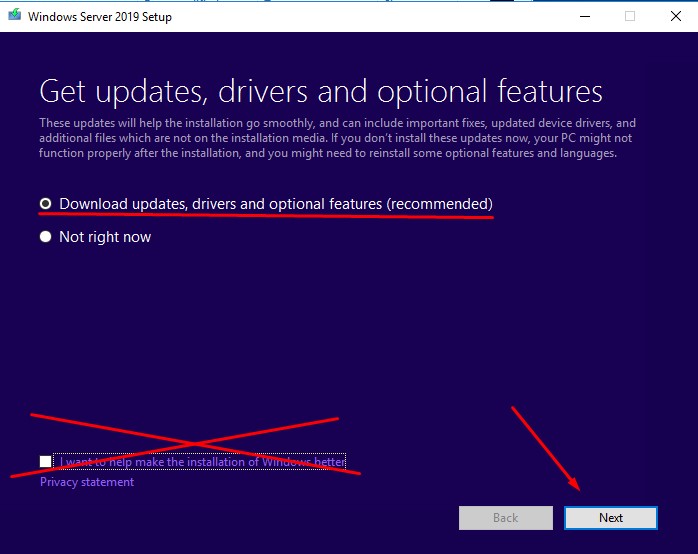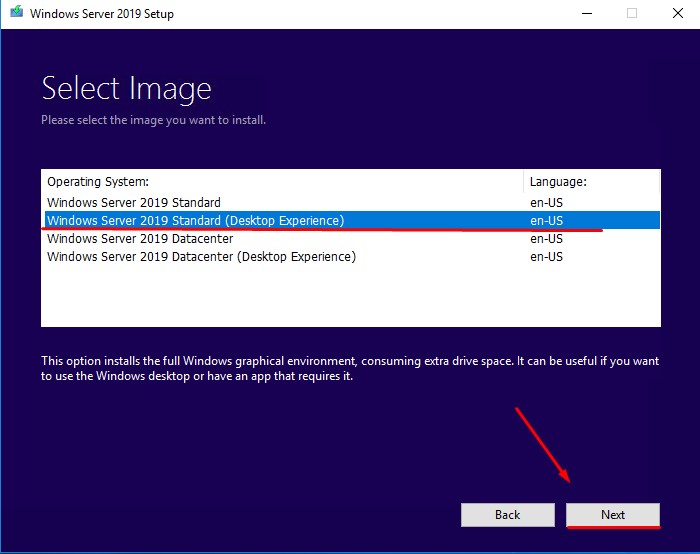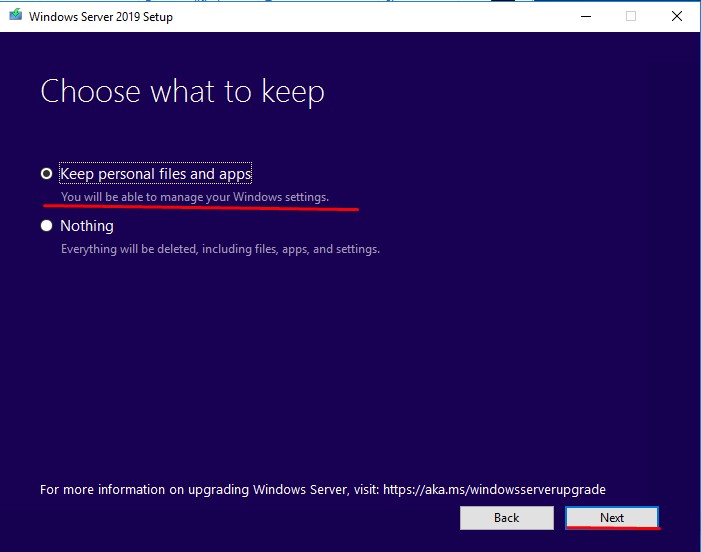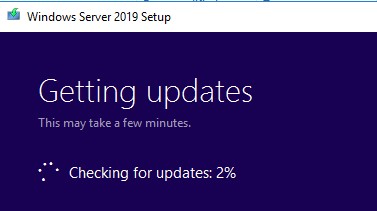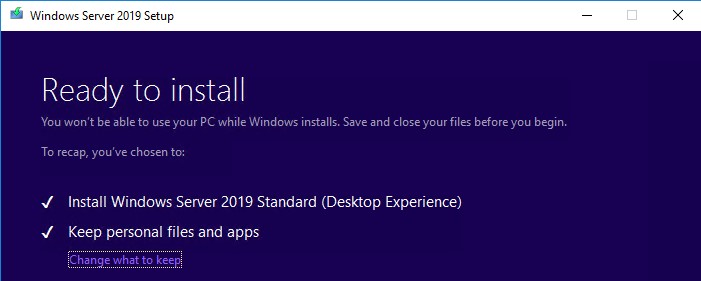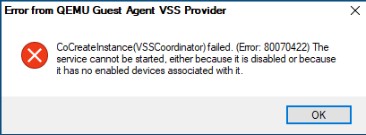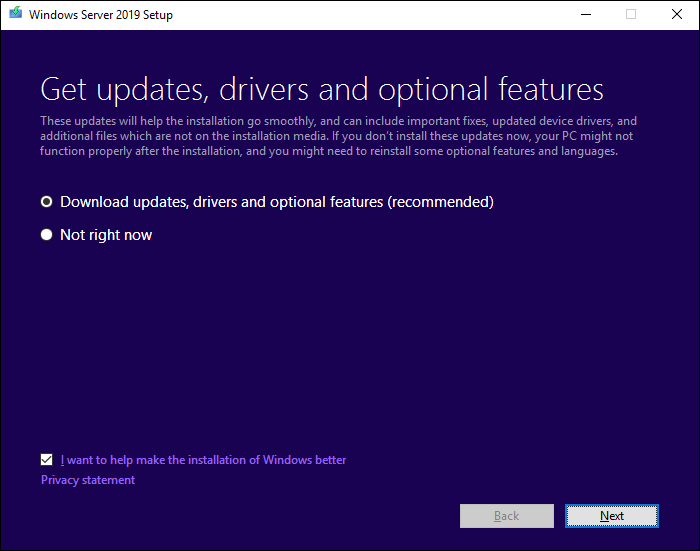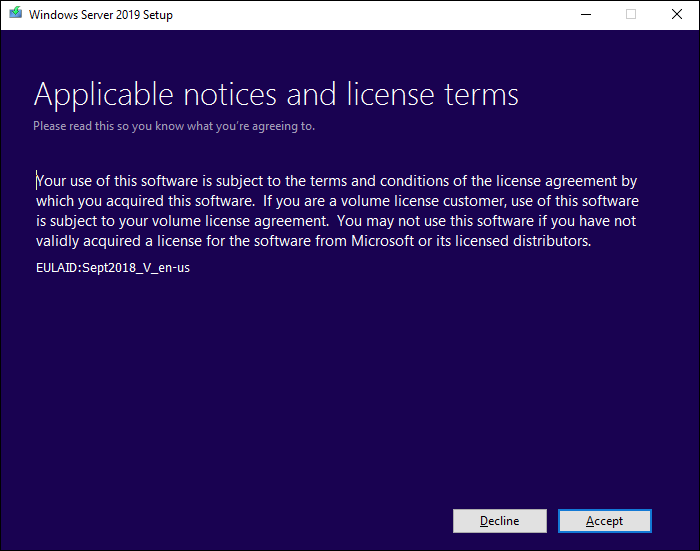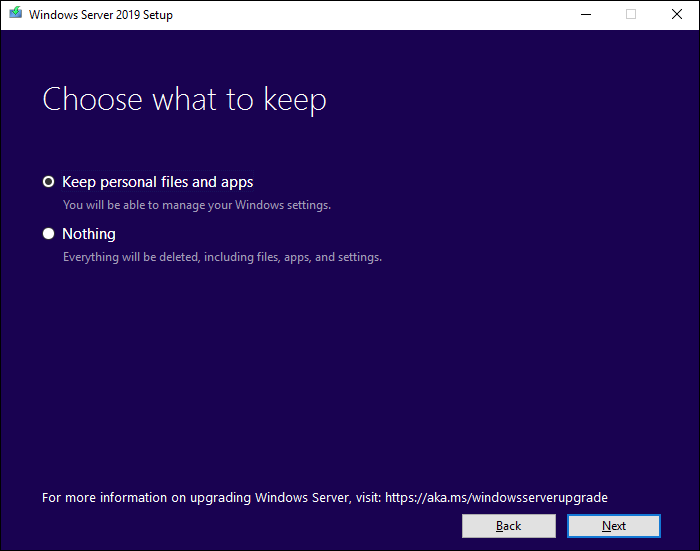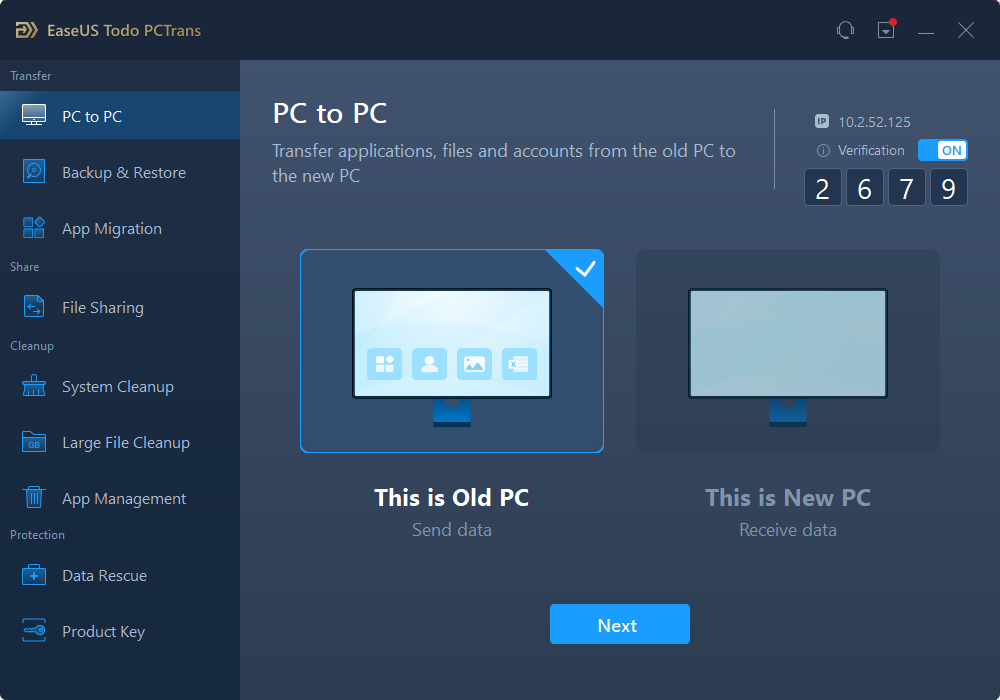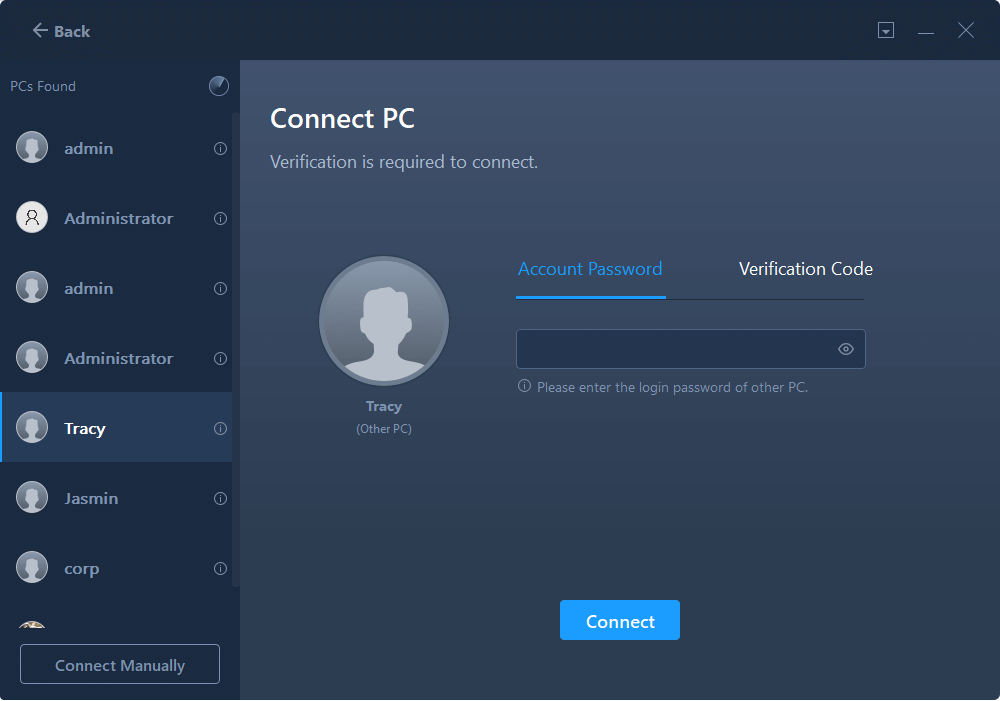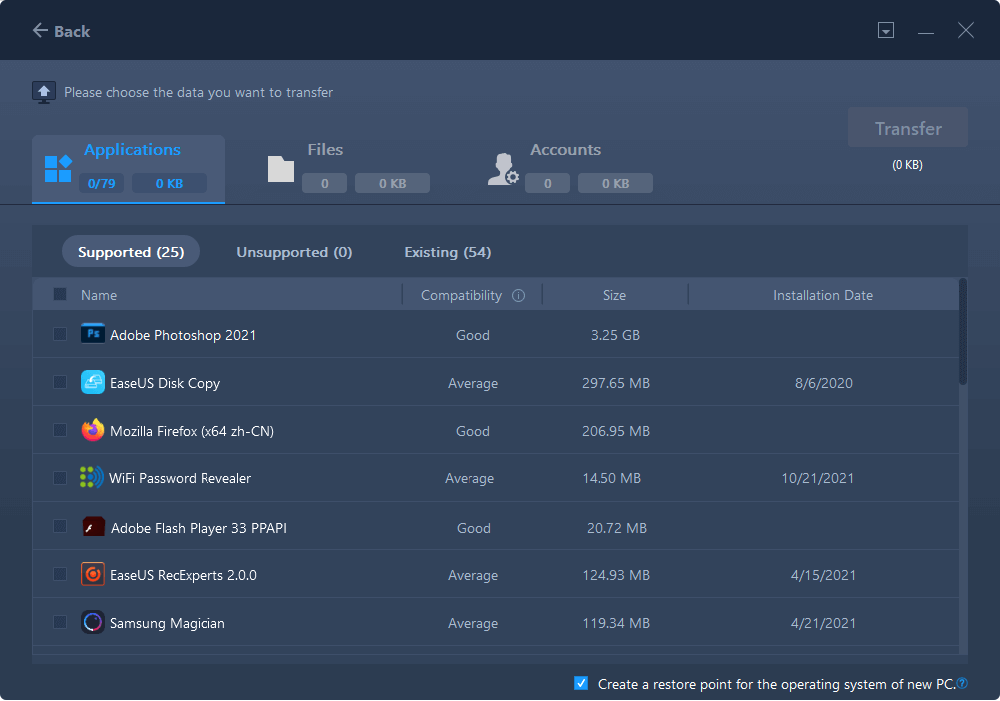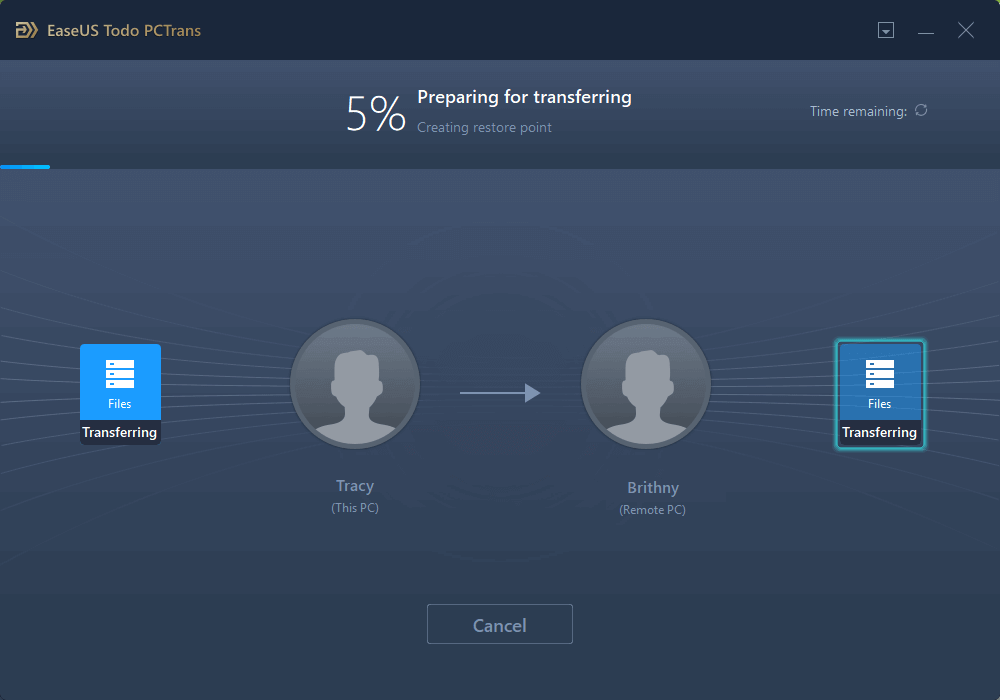- 06.09.2019
В Windows Server 2016 существует возможность апгрейта (обновления) до Windows Server 2019, все настройки и файлы при этом сохраняются. Установка Windows Server 2019 возможна так же к примеру из под Windows 10, но в этом случае сохранить личные файлы при данном способе обновления будет невозможно.
1) Прежде чем приступить к обновлению убедитесь в следующих важных аспектах:
1. Не обслуживает ли сторонняя компания данный сервер? У них могут быть свои ньюансы, уточните пожалуйста, если Вы не главный администратор данного сервера.
2. Не защищены ли диски данного сервера шифрованием BitLocker? Иначе при обновлении необходимо будет их расшифрование.
3. Не является ли сервер одной частью отказоустойчивого кластера?
4. Есть ли свободное место на жестком диске для обновления (Минимум 8гб HDD).
5. Обязательно сделайте резервное копирование данного сервера.
6. Убедитесь, что сервер полностью исправлен. Настоятельно рекомендуется, что бы на данном сервере как железо, так и с софтверной частью все корректно работало.
2) Скачайте и запустите установочный файл Windows Server 2019. Скачать можете на следующей странице.
3) Рекомендуется загрузить обновления сразу, так же загрузятся автоматически драйверы и дополнительные функции.
4) Программа установки проверит конфигурацию Вашего компьютера (сервера).
5) На следующем этапе в зависимости от Вашей исходной операционной системы у Вас может запросить лицензионный ключ активации для Windows Server 2019, что бы продолжить дальше.
6) На данном этапе Вам предложат выбрать нужную Вам редакцию Windows Server 2019.
7) Принимаете лицензионное соглашение.

9) Устанавливаем обновление. Сервер несколько раз перезагрузится до завершения обновления.
После установки и завершения обновления, зайдите в свойства системы и убедитесь, что обновление произведено до Windows Server 2019.
Задача: Проработать обновление Windows Server 2016 до Windows Server 2019
Как по мне использовать обновление серверной операционной системы Windows с одного релиза на другой с установленными сервисами – это обрекать себя на получение дополнительных проблем и порой не понимания, а почему сервисы перестали работать. Уж лучше развернуть их заново с нуля по своим наработкам, да долго и время, но так Вы будете уверены, что работает как нужно. Я хочу в тестовых условиях под Debian 10 + Proxmox 6 проработать процедуру обновления виртуальной машины Windows Server 2016 Standard установленной из образа: SW_DVD9_Win_Server_STD_CORE_2016_64Bit_English_-4_DC_STD_MLF_X21-70526.ISO. Возможно и буду использовать данную заметку, а возможно и нет, все решит случай.
Требования:
RAM: не менее 4GbHDD: на логическом диске C: должно быть свободно не менее 40GbEth: потребуется выход в интернет или доступ к WSUS сервису для выкачивания обновлений.Права локального администратора в системеСлужба Windows Updates должна быть включена
Шаг №1: Запускаю VM srv-s2016 под Debian 10 + Proxmox 6
Шаг №2: Копирую дистрибутив Windows Server 2019 в систему.
У меня в моей локальной сети есть ресурс где лежат книги, программы, образа. С этого ресурса копирую образ Windows Server 2019 Std (SW_DVD9_Win_Server_STD_CORE_2019_1809.18_64Bit_English_DC_STD_MLF_X22-74330.ISO)
Шаг №3: Проверяю, что VM той редакции, которая нужна:
|
C:Windowssystem32>reg query «HKLMSOFTWAREMicrosoftWindows NTCurrentVersion» /v EditionID HKEY_LOCAL_MACHINESOFTWAREMicrosoftWindows NTCurrentVersion EditionID REG_SZ ServerStandard C:Windowssystem32>systeminfo | findstr /I «OS Name» Host Name: WIN—AAURVT4CB0C OS Name: Microsoft Windows Server 2016 Standard OS Version: 10.0.14393 N/A Build 14393 OS Manufacturer: Microsoft Corporation OS Configuration: Standalone Server OS Build Type: Multiprocessor Free BIOS Version: SeaBIOS rel—1.14.0—0—g155821a1990b—prebuilt.qemu.org, 4/1/2014 Time Zone: (UTC+03:00) Moscow, St. Petersburg, Volgograd Connection Name: Ethernet |
Все правильно.
Шаг №4: Распаковываю образ Windows Server 2019 Std, понадобится архиватор 7zip и запускаю процедуру обновления:
Запускаю C:SoftSW_DVD9_Win_Server_STD_CORE_2019_1809.18_64Bit_English_DC_STD_MLF_X22-74330setup.exe – Run as Administrator — выбираю вариант "Download updates, drivers and optional features (recommended) / Скачать обновления, драйверы и дополнительные компоненты (рекомендуется)"
I want to help make the installation for Windows better Privacy statement: снимаю галочку
И нажимаю Next
Выбираю выпуск Windows Server 2019 который в итоге будет, для меня это Windows Server 2019 Standard (Desktop Experience) и нажимаю Next
Нажимаю Accept
Choose what to keep: выбираю Keep personal files and apps (Сохранить личные файлы и приложения)
И нажимаю Next
Ожидаю, идет проверка
Getting updates
This may take a few minutes.
В итоге проверка завершается успешно, и установщик готов приступить
Ready to install
You won’t be able to use your PC while Windows installs. Save and close your files before you begin.
To recap, you’ve chosen to:
И нажимаю Install
Система по завершении самостоятельно отправится в перезагрузку
Вот что я получил в консоли Proxmox по этой VM, когда наблюдал за процессом обновления, но после снова продолжился процесс обновления как ни в чем не бывало.
Шаг №5: Система загрузилась, и я проверяю какая сейчас редакция:
|
C:UsersAdministrator>systeminfo | findstr /I «OS Name» Host Name: WIN—AAURVT4CB0C OS Name: Microsoft Windows Server 2019 Standard OS Version: 10.0.17763 N/A Build 17763 OS Manufacturer: Microsoft Corporation OS Configuration: Standalone Server OS Build Type: Multiprocessor Free BIOS Version: SeaBIOS rel—1.14.0—0—g155821a1990b—prebuilt.qemu.org, 4/1/2014 Time Zone: (UTC+03:00) Moscow, St. Petersburg Connection Name: Ethernet |
Отлично в тестовых условиях процесс обновления прошел успешно, а что до боевого, ну знаете я, пожалуй, пасс. Лучше работающий сервис чем после обновления не работающий вовсе. На этом заметка завершена, с уважением автор блога Олло Александр aka ekzorchik.
Categories
- Transfer Programs from C Drive to D Drive
- Transfer Installed Software to New PC
- Transfer Files from Old PC to New PC
- Transfer Microsoft Office
- Find Office Product Key
- Move User Folder
- Move Google Chrome Bookmarks
This article covers in-place server upgrade solutions and Server data migration from an old PC to a new PC. Figure out your target first:
If you want to start an in-place upgrade from Windows Server 2016 to Server 2019 or 2022, and keep all existing apps and files, locate Part 1.
If you want to change old devices and plans to migrate applications, databases, domain accounts, user profiles from one server to another, see Part 2.
| Workable Solutions | Step-by-step Troubleshooting |
|---|---|
| Part 1. How to Upgrade Windows Server to 2019/2022 | Start Server setup > Click setup.exe…Full steps |
| Part 2. How to Migrate Server 2016 to 2019 of 2022 | Download EaseUS Todo PCTrans > Click «Backup»…Full steps |
According to Microsoft, Windows Server 2016 will continue to update until Jan 12, 2027. And the end of life for Windows server 2019 is Jan 9, 2029. Windows Server 2022 has released in Sep 2021.
Even though Windows Server 2016 still acts as the main workhorse on many companies, we recommend upgrading to the latest version due to the new security function and better performance.
Comparison of Windows Server 2016 vs. 2019
Windows 2019 updates storage migration service, Kubernetes platform support, unified management, virtual network peering, enhanced Windows Defender ATP, etc. However, Window Server 2016 has removed iSNS, business scanning, remote desktop connection broker, remote desktop virtualization host, print components, and more.
Read Microsoft guide about editions comparison window server 2019.
Comparison of Windows Server 2019 vs. 2022
Server 2022 unveils four advanced functions of improved security: Hypervisor-based code integrity, secured-core server, hardware-enforced stack protection, and transport Layer Security (Enable TLS 1.3).
It also provides better platform flexibility, a new Windows admin center, upgraded Hyper-V Manager, Hybrid Cloud Support, and Enhanced Kubernetes Experience.
Learn more: check editions comparison server 2022.
Part 1. How to Upgrade Windows Server to 2019/2022
A step-by-step guide to performing In-Place Server Upgrade:
Phase 1: Start Server setup.
Step 1. Go to the Windows Server 2019 setup media, and then click setup.exe.
Step 2. Click Yes to Confirm the setup process.
Step 3. Then you can see the windows of «Get updates, drives, and optional features.» Select «Download updates, drivers and optional features (recommend)» and then click «Next.»
Step 4. Wait for setup to check the device configuration. When it finishes, select «Next.»
Step 5. Enter the Server license key to continue. (If you are confused about finding the Windows server product key, you can check this guide.)
Step 6. Select the wanted Windows Server 2019 image and then choose «Next.»
Step 7. Click «Accept» to agree with the Applicable notices and license terms.
Step 8. Choose what to keep and click Next:
Please choose «Keep personal files and apps» to keep data.
«Nothing» will cause all data to be deleted, including files, apps, and settings.
Step 9. After analyzing finish, you can click «Install» to prompt.
Phrase 2: Check whether the system is successfully upgraded.
Type Registry Editor on the search box and click to open it:
Follow the path to see ProductName: ComputerHKEY_LOCAL_MACHINESOFTWAREMicrosoftWindows NTCurrentVersion
Your ProductName should be Windows Server 2019. Remember to check all applications are running well. If apps or files are lost, EaseUS Todo PCTrans can help you create image files to keep everything.
If you find Windows Server goes wrong, you can follow the path (C:WindowsPanther) and zip the files. Then, contact Microsoft to help you.
Part 2. How to Migrate Server 2016 to 2019 of 2022
If the in-place upgrade is not your option, please shed light on Server Migration to move data quickly. For Server users, it is a headache to find a cost-effective and flexible method to transfer files and data, even users’ accounts and domain accounts, to a new PC.
This part will give you another choice to migrate all programs, files, and settings — Download the Windows Server migration tool. Advanced Windows Server PC transfer utility — EaseUS Todo PCTrans Technician is capable of Windows Server transfer solution between Server 2003/2008/2012/2016/2019/2022.
EaseUS Todo PCTrans Technician
- ☆ Deploy & install Todo PCTrans on multiple PCs.
- Transfer unlimited files, programs, apps between Servers.
- Transfer account, domain account, and settings.
- Data rescue, find product key of installed programs.
- One license for multiple PCs.
Still, hesitate to use EaseUS Todo PCTrans? Check the video guide. Get more info about this advanced Windows Server file & app transfer software.
Steps about migrating to Windows Server 2019/2022:
Step 1. Launch EaseUS Todo PCTrans on your source and target computers, connect both PCs via the internet.
1. At the «PC to PC» section, click «PC to PC» to continue.
2. Select your target computer via its device name, then enter its account password or verification code and select the transfer direction. Then click «Connect» to continue.
You can check the verification code on the right top of «PC to PC» mainscreen on the target computer.
Step 2. Select the categories Applications, Files, and Accounts to transfer via the internet.
If you want to transfer data selectively, click «Edit» under each category, and choose the specific items.
Step 3. Click «Transfer» to start transferring your apps/files/accounts from one computer to another computer via the Internet.
Final Thoughts
This post provides two parts in Server upgrade and Server migration. If you focus on upgrading Windows Server 2016 to 2019 or 2022, a Windows built-in method is enough to complete the task. One more important thing — here is a case that in-place upgrade turns to wrong and your data lost. So, to protect your data, we recommend making a backup image by EaseUS Todo PCTrans.
In addition, data transfer also becomes the client’s purpose. Therefore, you can enjoy the direct migration to Server 2019 or 2022.
In this blog I am sharing how I upgraded my Windows Server 2016 Hyper-V host that been running an Intel NUC for a solid 3 years now to Windows Server 2019. Before anything else I’m taking my collecting my current server info (reference link: here)
- Open a command prompt and type systeminfo.exe.
- Copy, paste the info to a notepad or OneNote save to another device or storage other than the machine that will be upgrading.
- Type ipconfig /all and take note of the IP settings.
- Open the Registry Editor this this hive:
HKLMSOFTWAREMicrosoftWindows NTCurrentVersionand take note the Windows Server BuildLabEx (version) and EditionID (edition).
It’s also worth the trouble to that we backup the operating system, apps, and virtual machines.
As you can see above, we can’t have any virtual machines running during the in-place upgrade process, so we have to make sure that they are turned off.
Now, after this checklist are met, it’s time to launch the Windows Server 2019 installer.
If you are prompted a UAC – click Yes.
The next screen will ask for either Download updates, drivers and optional features (recommended) or Not right now options, if your device is internet-connected you may select the first option and then select Next.
Enter your Windows Server 2019 Product, in this example I have a Standard License (you won’t see any Datacenter options here).
I selected the Windows Server 2019 Standard (Desktop Experience) then clicked Next.
Select Accept to accept the terms of your licensing agreement
On the next screen you may select to Keep your personal files and apps or just wipe everything, I have chosen the keep my files, then I clicked Next.
The setup will then analyzes the device and will call your attention if needed (same in the example above of the running VMs), once all is good to go it will prompt you to proceed with the Installation.
Click install to proceed.
After the upgrade is completed, verify that the upgrade to Windows Server 2019 was successful by going the the System Properties.
Now this Windows Server 2019 is ready.
It is always a good idea to start a new Windows Server 2016 / 2019 installation on a new slate. However, in some instances, you may be working on a site that will force you to upgrade from the current installation to the latest version.
The routines described here apply to the server versions of Windows 2016 and 2019. This article describes moving to Windows Server 2016 / 2019 from different lower server platforms.
The path to the new Operating System (OS) depends on the current system and configurations that you are running.
That being the case, the following terms define activities you are likely to encounter when deploying the 2016 Server.
Installation
The simplest way of installing a new OS to work on your hardware, and get a clean installation, demands that you delete the previous Operating System.
Migration
To move system settings to the new Windows Server using a virtual machine is what we call migration. The process also varies depending on the roles and system configurations already running.
Cluster OS Rolling Upgrade
This feature is new in Windows Server 2016, and its role is to make sure the Administrator can upgrade the Operating System of all nodes running Windows Server 2012 R2 to Windows Server 2016, without interfering with the Hyper-V or Scale-Out File Server workloads.
The feature also helps in reducing downtime, which may affect Service Level Agreements.
License Conversion
Some Operating Systems use releases that allow the conversion of one edition to another without so much struggling.
What you need is a simple command issued alongside a license key, and you end doing the license conversion.
Upgrade
When you want to use the latest software that comes with the newer versions, then you have to do an upgrade.
In-place upgrades mean using the same hardware for installing the new Operating System. For example, you can upgrade from evaluation to retail version or from a volume license to an ordinary retail edition.
NOTE 1: An upgrade will work well in virtual machines if you do not need specific OEM hardware drivers.
NOTE 2: Following the Windows Server 2016 release, you can only perform an upgrade on a version installed using the Desktop Experience (not a server core option).
NOTE 3: If you use NIC teaming, disable it before you perform an upgrade; and when the upgrade is complete, re-enable it.
Upgrade Retail Versions of Windows Server to Windows Server 2016 / 2019
Note the following general principles:
- Upgrading a 32-bit to 64-bit architectures is not possible. Note that all Windows Server 2016 versions are only available in 64-bit.
- You cannot upgrade from one language to another.
- If you are running a domain controller, make sure you can handle the task, or read the following article: Upgrade Domain Controllers to Windows Server 2012 R2 and Windows Server 2012.
- You cannot upgrade from a preview version.
- You cannot switch from Server Core installation to a Server with a Desktop installation.
- You cannot upgrade from a Previous Windows Server installation to an evaluation copy of Windows Server.
You can read from the table below that shows a summary of Windows Operating Systems available for upgrade. If you are unable to upgrade your current Windows version, then upgrading to Windows Server 2016 is impossible
| Current Windows Edition | Possible Upgrade Edition |
|
|
|
|
|
|
|
|
|
|
|
|
|
|
|
|
|
|
Per-Server-Role Considerations for Upgrading
It’s important to consider server roles before performing an upgrade.
For example, some server roles are part of the newer Windows versions and may only need additional preparation or actions to get the desired intent.
Converting Current Evaluation Version to Current Retail Version
It is possible to convert the trial version of Windows Server 2016 Standard to a Data 2016 Standard Server or a Datacenter version. The two conversions can be retail versions. You can also convert Windows Server 2016 Datacenter to the retail version.
Before making any conversion attempts to the retail version, ensure that your server is running an evaluation version; you can confirm this by following these steps:
- From the administrator’s command prompt, run
slmgr.vbs /dlv;
- The evaluation versions will include “EVAL” as the output
- Open the control panel
- Then click on System and Security
- Click on System
- View the activation status found on the activation area of the System page
- Click view details, and you will see more information on your Windows Status
- If your Windows is activated, you will see information showing the remaining time for the evaluation period.
If you are running a retail version, you will see the “Upgrading previous retail versions of Windows Server 2016” message prompting you to upgrade to Windows Server 2016.
In Windows Server 2016 Essentials, the conversion to retail version is possible if you have a retail volume license or OEM key in the command slmgr.vbs
In case you are running an evaluation version of Windows Server 2016 Standard or Windows Server 2016 Datacenter, the following conversions can help you:
- If the server is a domain controller, it cannot change to the retail version. First, install another domain controller on a server that runs a retail version and remove the AD DS from the domain controller that has the evaluation version.
- Read the license terms
- From the administrator’s command prompt, enter this command to get the current edition:
DISM /online /Get-CurrentEdition
Note the edition ID, the abbreviation form of the edition name, and then run the following command:
DISM /online /Set-Edition:<edition ID> /ProductKey:XXXXX-XXXXX-XXXXX-XXXXX-XXXXX /AcceptEula
Once you get the ID and product key, the server should restart twice.
You can convert the evaluation version of Windows Server 2016 Standard to the retail version of Windows Server 2016 Datacenter using the same command and product key.
Converting Current Retail Edition to a Different Current Retail Edition
After successful installation of Windows Server 2016, you can run setup to repair the installation using a process called “repair in place” that converts it to a different edition.
In case of Windows Server 2016 Standard, you can convert the system to Windows Server 2016 Datacenter by:
- From the administrator’s command prompt, use the following command to determine the existing edition:
DISM /online /Get-CurrentEdition
- Run this command to get the ID of the edition you want to upgrade to:
DISM /online /Get-TargetEditions
- Note the ID edition, the name of the edition, and then run this command:
DISM /online /Set-Edition:<edition ID> /ProductKey:XXXXX-XXXXX-XXXXX-XXXXX-XXXXX /AcceptEula
- Once you get the ID and product key, the server should restart twice.
Converting Current Retail Version to Current Volume Licensed Version
Once you have Windows Server 2016 running, you can convert it to a retail version, an OEM version, or a volume-licensed version. The edition will not change.
If the starting point was an evaluation version, change it to retail version and then do as follows:
- From the administrator’s command, run this command:
slmgr /ipk <key>
- Insert the appropriate volume license, OEM or retail key instead of <key>
Conclusion
Upgrading Windows Server is a complicated process; therefore, Microsoft suggests that you migrate all roles and settings to Windows Server 2016 to avoid costly mistakes.
The Windows Server 2016 is a cloud-ready operating system that delivers new layers of security and Azure-inspired innovation for the applications and infrastructure. If you would like to try this out in a lab environment, download it here. In some of my other posts, We have gone through the installation of Windows Server 2016 and the installation of Windows Server 2019. Also, I have configured and deployed Windows 10 via Windows Deployment Services (WDS).
See these guides for more information on how to set up a VM via PXE boot on a Generation 1 VM and how to set up a VM via PXE boot on a Generation 2 VM. Note: You can do an in-place upgrade from Windows Server 2012 R2 to Server 2019.
On my Windows Server 2016 lab VM. I mounted the Windows Server 2019 iso file, so let’s upgrade. In my next article, I will be demonstrating how a server can be upgraded from WS 2012 to 2019. As you can see below, we are currently running Windows Server 2016, Datacenter Evaluation Edition.

Here are the Windows Server 2019 Install Options;
– Server Core: It’s a smaller installation that includes the core components of Windows Server and supports all server roles, but does not include a graphical user interface (GUI).
– Server with Desktop Experience: This is the complete installation and includes a full GUI for customers.
Windows Server 2016 requires a direct upgrade process unlike Windows Server 2012. We will be proceeding with the installation as shown below.
– Mount the WS 2019 ISO Image on WS 2016 VM as shown below. Download Virtual Clone in order to do this.

Double click on the mounted ISO in order to continue the setup

This will open up the Windows Server 2019 setup as shown below
– Click on Download Updates, drivers and Optional features (recommended).
– Click on Next

This will check for updates and also check your PC

This will launch the setup “Select Image” window as shown below
– Click on Next

Accept the License as shown below

This will open up a new window instructing you on what to keep. I will go with “Nothing”
– Click on Next

When you choose nothing, this will prompt you to select yes in order to be very sure you want to continue

Windows will collect updates and when prepare the system for installation.
This will make sure your system has enough space to install the Operating System and ensure everything is ok.

This will prompt the Read to Install Window as shown below
– Click on Install as shown below.

Now the server upgrade process begins as shown below. This can take a while!
The following windows below show Windows Server 2019 is still installing.
– Note: Your server will restart multiple times.
Let customise the server by entering the following information as it relates to you.
– When you are done, click on Next

Enter the password to your Administrators account as shown below
– This step will finalise the Windows Server 2016 to Windows Server 2019 Upgrade

When Windows is done applying settings, you can now log on to your server a shown below.

Now we are logged on to the server, lets access the server system properties as shown below.

Now we are done upgrading to Windows Server 2019. You can install additional roles and features needed to make this server operational. For some examples, see the following links below. how to set up a Domain Controller, how to add a second Domain Controller to your environment, how to install and configure Active Directory Federation Service (ADFS) in Windows Server, and how to install Dynamic Host Configuration Protocol on Windows Server 2019.
Here you can have a look at the basic settings such as the time zone, ITÉ security setting, firewall, and Remote Desktop, etc. For the configuration of a new server, see this guide “Post-installation of this server“.

To ensure everything was successfully upgraded, we need to access the registry.
On the server, run RegEdit. Check the value of the HKEY_LOCAL_MACHINESOFTWAREMicrosoftWindowsNTCurrentVersion hive. The version should show Windows Server 2019. See the following articles below for more information about the Windows registry.
- How to search through the Windows registry.
- For what Registry Editor is and how to access the registry hives.
I hope you found this blog post helpful. If you have any questions, please let me know in the comment session.









